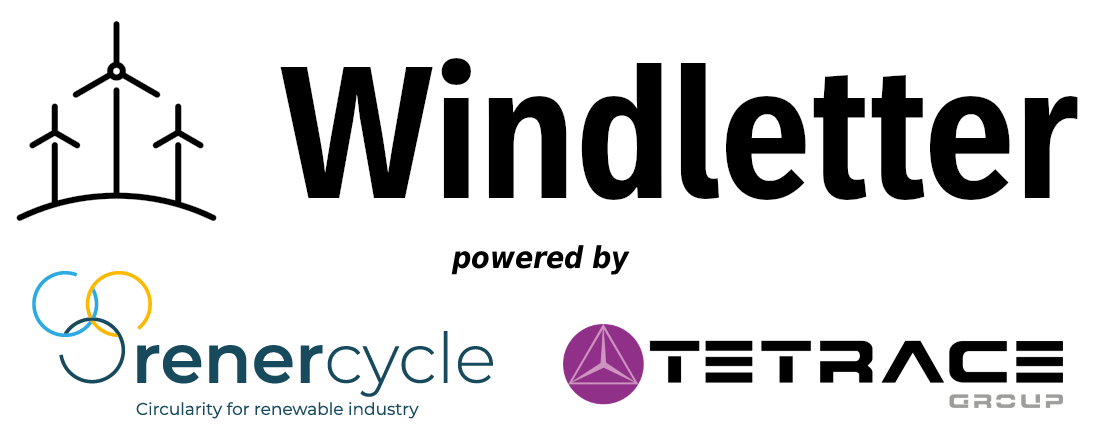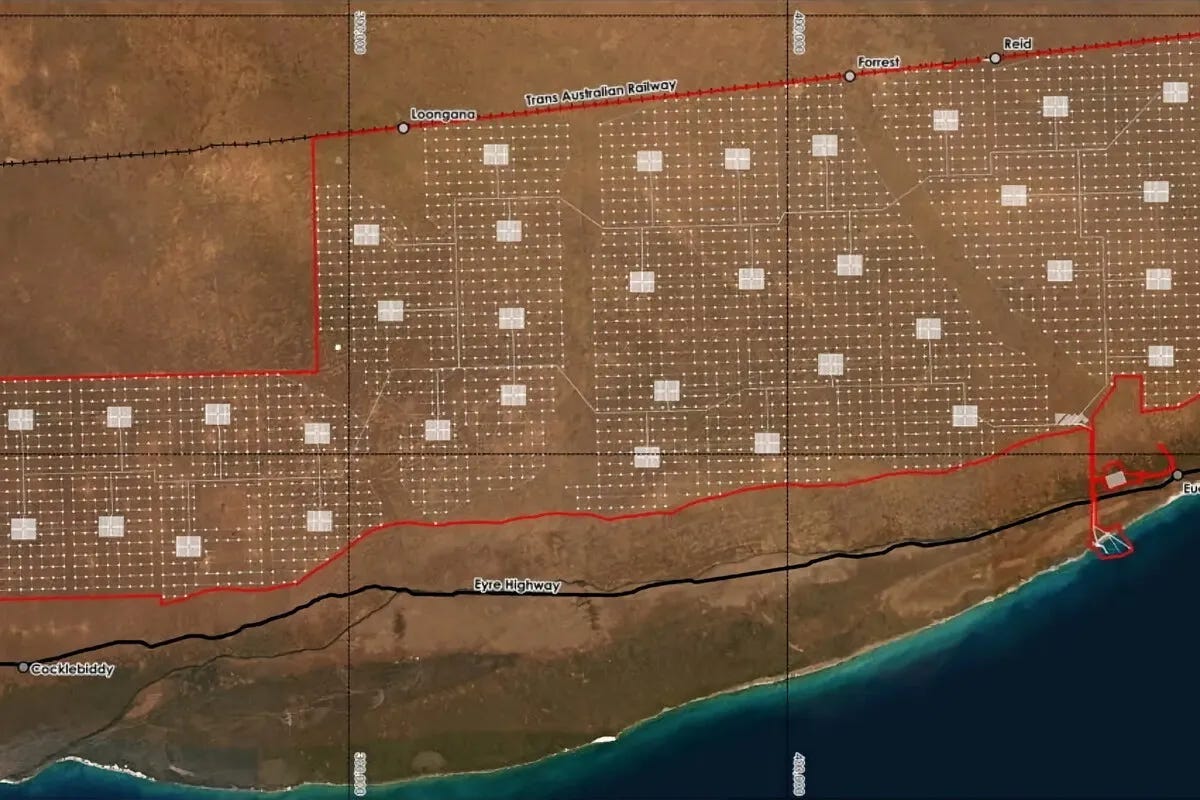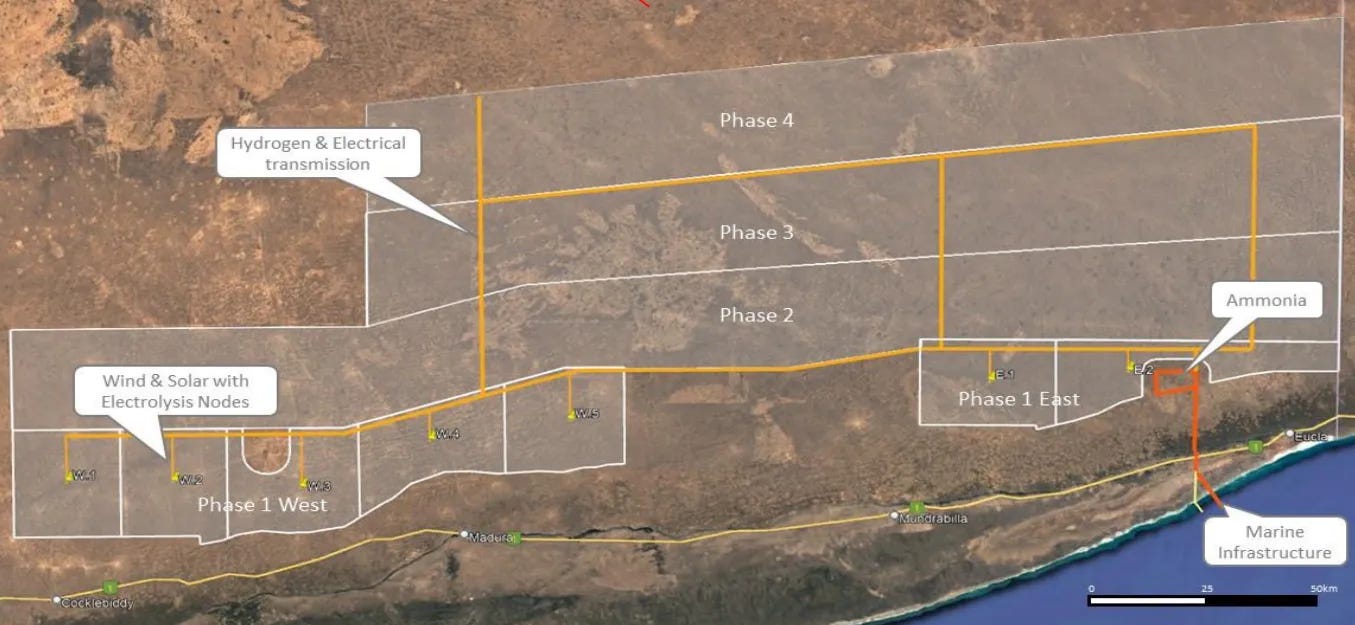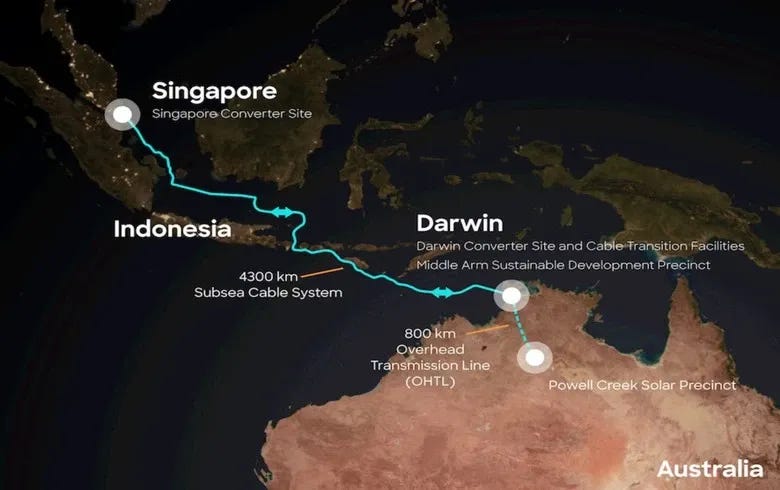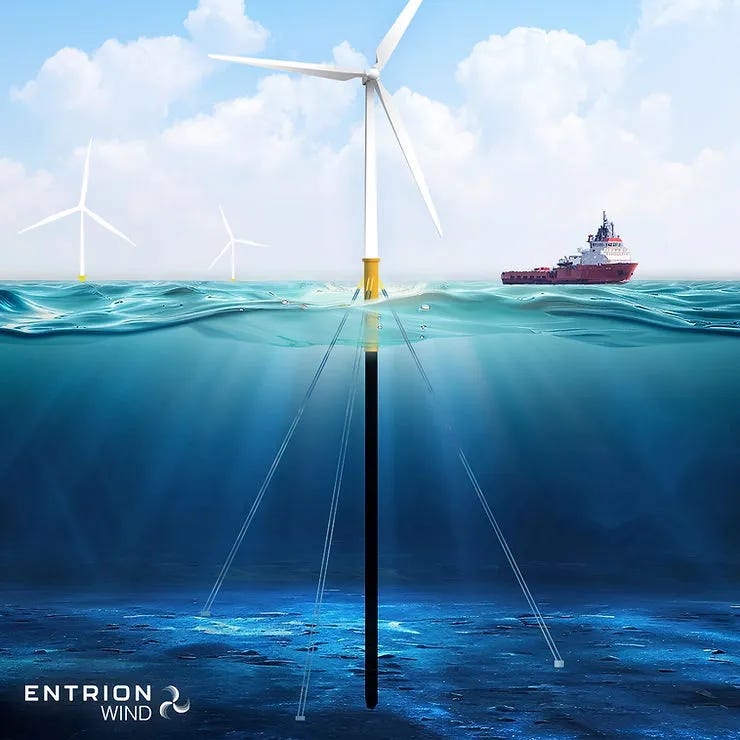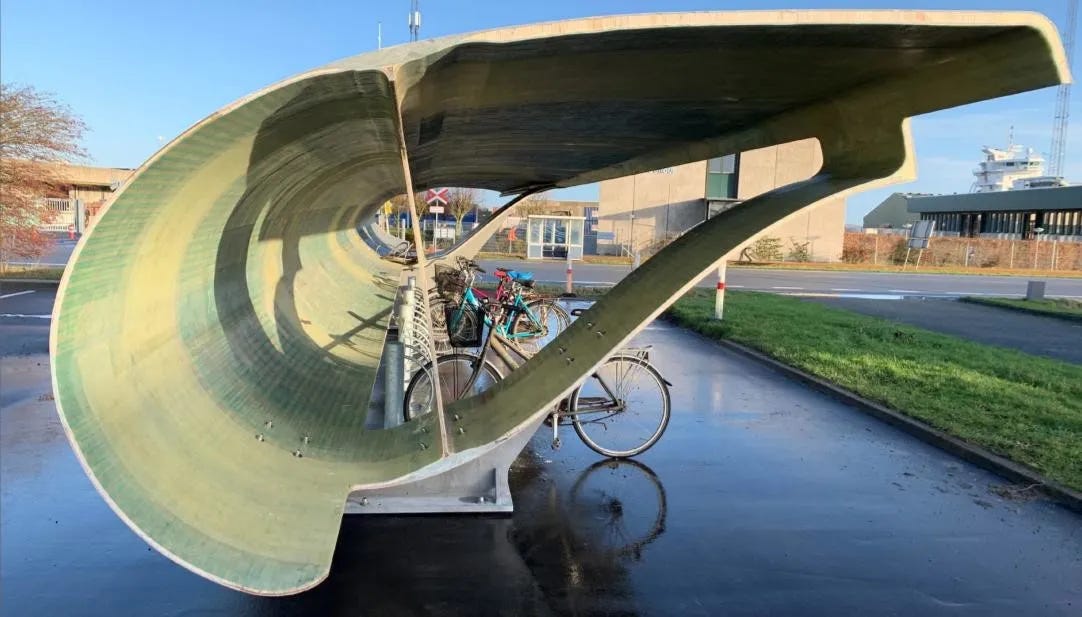Windletter #95 - The largest renewable project ever planned
Also: Inauguration of the second prototype of the Vestas V236-15.0 MW, monopiles for 100-meter depth, recycling blades to build a boat, and more.
Hello everyone and welcome to a new issue of Windletter. I'm Sergio Fernández Munguía (@Sergio_FerMun) and here we discuss the latest news in the wind power sector from a different perspective. If you enjoy the newsletter and are not subscribed, you can do so here.
Windletter is sponsored by:
🔹 Tetrace. Specialized services in operation and maintenance, engineering, supervision, inspection, technical assistance, and distribution of spare parts in the wind sector. More information here.
🔹 RenerCycle. Development and commercialization of solutions and specialized services in the circular economy for renewable energies, including comprehensive dismantling of wind farms and waste management, refurbishment and sale of components and wind turbines, management and recycling of blades and others. More information here.
Windletter está disponible en español aquí
The most-read pieces in the latest edition have been: the DTU paper on designing wind turbines optimized for capturing higher revenues, the article on the first year of Saitec Offshore's DemoSATH, and the autonomous robot for tightening bolts.
Let's get to this week's news.
🌱 A 70 GW renewable project larger than Slovenia
Today, let's talk about a massive renewable project proposed in Australia: the Western Green Energy Hub (WGEH).
The figures are staggering. This is one of the largest and most ambitious renewable energy projects in the world, planned to cover an area of no less than 22,700 square kilometers on the desert coast of Western Australia. To put this into perspective, we are talking about an area larger than countries like Slovenia or El Salvador.
The proposed site for its installation is one of the least densely populated areas in Australia, a country where there are only 3 people per square kilometer.
WGEH would be built in several phases, with the first phase comprising about 8 GW of combined wind and solar power. However, the plans involve installing 3,000 wind turbines ranging from 7 to 20 MW and 60 million photovoltaic panels. Assuming 10 MW wind turbines and 700 W photovoltaic panels, this would give an installed capacity of 30 GW wind and 42 GW solar. All of this would be accompanied by equipment for hydrogen production.
The developers claim it could generate more than 200 TWh of renewable energy per year. To put it into perspective, electricity demand in Spain is under 250 TWh, and in Australia, the demand was 274 TWh last year.
According to the current plans, which already have a feasibility study, the complex would include:
Wind and solar power generation assets and green hydrogen production via electrolysis, along with the necessary electrical connection infrastructure and hydrogen connection infrastructure.
A processing and production area where the generated hydrogen will be converted into green fuels and possibly used and/or sold for various value-added products.
Support and service infrastructure, including a maritime unloading facility, desalination plants, and facilities for staff, residential areas, and commercial spaces.
Currently, as part of the preliminary work, the following activities are being carried out:
Wind and solar radiation measurement campaign: With equipment collecting data for at least 12 months.
Environmental studies: Assessing flora, fauna, and marine biodiversity at the site.
Cultural preservation: Working with the native Mirning people and landowners to protect areas of high cultural value.
Database update: Providing new scientific and cultural data to state databases.
The Western Green Energy Hub is being developed by a consortium comprising Intercontinental Energy, based in Hong Kong; Serbian developer CWP Global; and Mirning Green Energy, a renewable energy company founded in 2021 by Indigenous Peoples to drive the development of the project.
There is quite a bit of information on their website if you want to take a look.
This project reminded me of the Australia-Asia Power Link (AAPowerLink), a transmission line of around 5,000 kilometers (around 4,300 kilometers submarine and 800 kilometers of overhead line) that aims to transport electricity from northern Australia to Singapore and has recently reached an important environmental milestone.
The truth is that these massive projects look great in .ppt presentations, but I can’t help but see them as projects straight out of a futuristic science fiction movie.
It’s a bit hard to believe we’ll see them fully materialized one day. But who knows.
_
📉 Stock prices of several manufacturers and developers drop after Trump’s victory, but no need to panic
Trump's victory in the U.S. elections has shaken up the wind industry a bit.
On the one hand, the first reaction was that the stocks of Vestas, Nordex, and Ørsted plummeted upon hearing the news. This seems logical given that we are talking about a president who literally declared that wind turbines are "a pile of junk" and promised to halt offshore wind development on the first day of his mandate.
It seems reasonable to think that the next four years won't be the golden age of wind in the United States, but there are reasons to believe we’re not heading into a scenario as catastrophic as many might think.
Not far off, a chart published in The Washington Post shows that 70% of investments in clean manufacturing (or factories related to the production of so-called clean technologies) from the IRA have gone to Republican districts. Additionally, considering Trump’s preference for protectionism and local manufacturing, it’ll not be easy for him to undermine his own base.
Moreover, reactions in the industry haven't been especially alarming:
Nordex is maintaining its plans to reopen its factory in Iowa.
Vestas’ CEO bought 10,000 shares (almost €150,000) of the company after the drop following Trump’s victory.
Anyway, we'll have to wait and see how it actually impacts.
_
⚡ Second prototype of the Vestas V236-15.0 MW, community-owned, inaugurated
Vestas is moving forward with its second prototype of the V236-15.0 MW. A somewhat special prototype, as it has been installed at the Thyborøn port and is community-owned.
Specifically, the turbine has been funded by more than 2,800 local shareholders, who also hope to turn it into a tourist attraction.
These community projects have a special kind of romance, and Vestas has wanted to reflect this in the video I’ve included below:
It’s nice to see people happy, proud, and involved in the construction of this wind turbine. It’s also very interesting to see the crowd event that its inauguration turned into.
I know that such community projects are common in Germany, but in Spain, they are a rarity, and it’s a real shame. The only case I can think of is Viure del Aire, with a single Enercon E-103 EP2 turbine of 2.35 MW in the Catalan municipality of Pujalt.
I’m not sure if it’s a cultural issue or because it's more attractive and/or easier to carry out from a regulatory standpoint in other countries. Maybe we should promote a community wind turbine among the subscribers of Windletter 😂
_
🌊 Entrion Wind patents a guyed monopile to bring fixed-bottom offshore wind to depths of 100 meters
The maximum depth for installing fixed-bottom offshore wind using monopiles is currently around 60-70 meters. This is a limitation that has several aspects:
Economic: The longer the monopile, the higher the CAPEX, and that investment needs to be supported by a tariff (or expected revenue from electricity sales).
Manufacturing: The main limiting factor would be the size, the plant's load-bearing capacity, and the handling equipment required to move these giant components. It should be noted that monopiles usually go at least 25-30 meters into the seabed, giving us a total monopile length of up to 100 meters just with current depths.
Design: There are stiffness and stability challenges with monopiles of these lengths.
In order to overcome these challenges, Entrion Wind has patented a monopile design they've named the Fully Restrained Platform (FRP) monopile.
Entrion Wind's design extends the maximum feasible depth for monopiles to 100 meters. It does so by adding several guy wires to the structure, improving the monopile's stability and increasing its stiffness. It reminded me of Vestas' guyed tower.
According to Entrion Wind, their design could make viable offshore projects that were previously only possible with floating structures. Commercial deployment is planned for 2027.
The potential to extend fixed-bottom wind to greater depths is spectacular. According to Aegir Insights' calculations, just considering foundations that could reach 100 meters depth, 50 GW could be unlocked in the UK and Ireland alone.
_
♻️ Recycling wind turbine blades to build a boat
Recently, there’s been a lot of talk about recycling wind turbine blades. Although recycling it's often confused with reuse.
Reuse means taking the blades themselves, after some modifications, to create structures with different uses. This is the case with the famous playgrounds we’ve talked about or the well-known bicycle parking I’m showing below.
However, true recycling means recovering the raw materials from the blades and using them in another manufacturing process. This has been the case with the Second Wind Project, a collaboration between Siemens Gamesa and Resolve Composites.
As shown in the video, this project has built a boat using fiberglass recovered from Siemens Gamesa wind turbine blades, demonstrating the feasibility of this type of process.
To recover the fiberglass, they used a process called ReceTT, which claims to reduce the solvent needed by 70%. You can read more information here.
Of course, this is a pilot project, but it’s a clear demonstration of the feasibility of recovering these materials and using them in a real-world application.
_
Thank you very much for reading Windletter and many thanks to Tetrace and RenerCycle, our main sponsors, for making it possible. If you liked it:
Give it a ❤️
Share it on WhatsApp with this link
And if you feel like it, recommend Windletter to help me grow 🚀
See you next time!
Disclaimer: The opinions presented in Windletter are mine and do not necessarily reflect the views of my employer.





